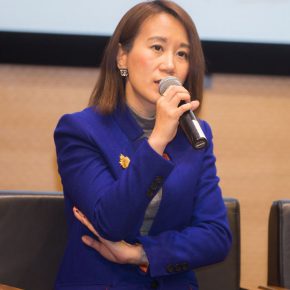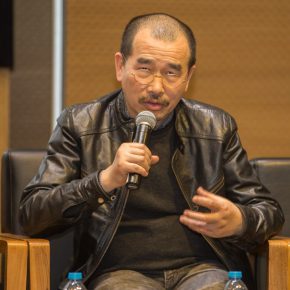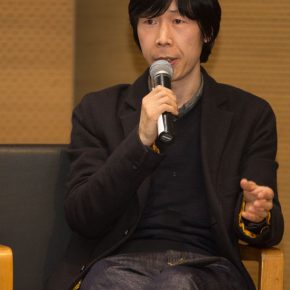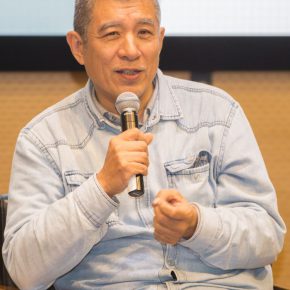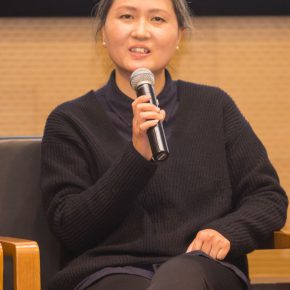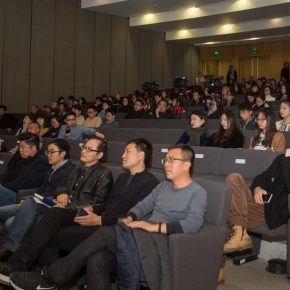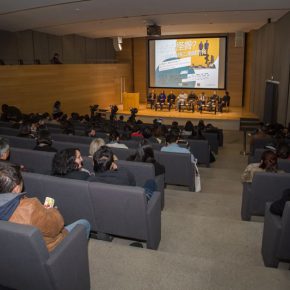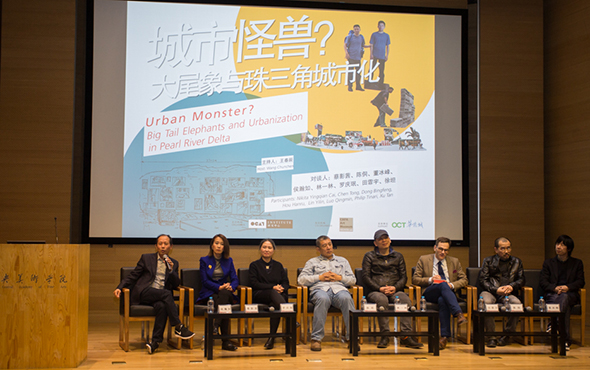
On the evening of March 15, 2017, a lecture entitled “Urban Monster? Big Tail Elephants and Urbanization in Pearl River Delta” was held at the Auditorium of CAFA Art Museum. It was presided over by Wang Chunchen, Head of the Department of Curatorial Research of CAFA Art Museum, and invited Nikita Yingqian Cai, Deputy Director of Guangdong Times Museum, Chen Tong, Head of the Guangzhou Borges Libreria Institute for Contemporary Art and Video Bureau, Hou Hanru, Art Director of MAXXI, Roma, Italy, and independent curator Dong Bingfeng, Philip Tarini, Director of the UCCA Beijing, as well as Lin Yilin and Xu Tan, members of Big Tail Elephants Working Group, as well as Luo Qingmin, the wife of the late Chen Shaoxiong, a member of Big Tail Elephants Working Group for a discussion.
At the beginning of the lecture, Prof. Wang Chunchen first introduced the “Big Tail Elephants” working group was established in the early 1990s, composed of artists Chen Shaoxiong, Liang Juhui, Lin Yilin and Xu Tan, who were active in the Pearl River Delta region centered on Guangzhou. The artistic activities initiated by the “Big Tail Elephants” were closely related to the social reality of the rapid development of the economy and urbanization in the Pearl River Delta region in the 1990s and it had a great impact on the contemporary art in China of the 1990s at the same time, because of the special avant-garde style of the creation and activities. Hou Hanru and Nikita Yingqian Cai jointly curated the “Delta Action the Big Tail Elephants – One Hour, No Room, Five Shows” held in the Guangdong Times Museum in 2016 to review the “Big Tail Elephants” which is based on Beijing OCAT Institute that presents the “One Hour, No Room, Five Shows” to finish and review the “Big Tail Elephants Working Group”, and it adds some search materials, many of which are presented to the public for the first time.
Hou Hanru said that the “Big Tail Elephants” group was very successful in art, it remained as inspiration with vitality, when people saw the works and programs, they would be surprised by them, and the problem discussed by them which was still a challenging major problem today.
As the curator of the exhibition and Nikita Yingqian Cai, Deputy Director of Guangdong Times Museum, as well as the researcher of documentaries of “Big Tail Elephants” said that, because the majority of the works created by the “Big Tail Elephants” in the 1990s disappeared, though the creation of “Big Tail Elephants” was closely related to the social context of the 1990s. How to place the works in the present context was a problem that must be faced, so it proved to be a great challenge to host an exhibition that combed through, researched and created a documentary for the art events of “Big Tail Elephants”. The mode of work for the exhibition is based on the interview of team members and their relatives and friends, the establishment and research of the depository, which is different from the general exhibitions.
As a member of “Big Tail Elephants” working group Lin Yilin talked about the process of the formation of the group, he said that the Chinese literary circle has been “cooled” and quiet for some time after 1989, different from many friends who chose to go abroad and went into business at this time, the members of the group chose to stay in Guangzhou, to engage in the artistic creation while maintaining a loose cooperation in the artistic activities in their spare time, and adhered to holding an exhibition annually, even when they couldn’t find an exhibition space in 1995, the group also chose to carry out artistic activities along the roadside. When it comes to the origin of the name of “Big Tail Elephant”, Lin Yilin humorously explained that the group members originally wanted to use the name of “monster”, and it was originally named “Big Rhinoceros Elephants”, but it was misread as “Big Tail Elephants” which has been retained.
Xu Tan, a member of “Big Tail Elephant” working group vividly shared memories of the team with the audience, to restore the “pictures” of the times. Xu Tan also said that, art activities of “Big Tail Elephants” had a strong sense of presence, so that it was difficult to succeed if it moved out of this special urban environment of Guangzhou. The creation of the “Big Tail Elephants” is not related to any oriental icon, representing the political concept of “de-politicization” of the artists, even though it was a naive and innocent view of the political environment that changed at that time, it reflected? the independence of the creative thinking of “Big Tail Elephants” on some levels.
Chen Tong, Head of the Guangzhou Borges Libreria Institute for Contemporary Art and Video Bureau is a close friend of the “Big Tail Elephants”, and he witnessed the establishment and development process of the “Big Tail Elephants”. Chen Tong recalled that he was the classmate of the members of “Big Tail Elephants”, as early on, when they were students he began to pay attention to the particularities of their artistic creations, for example, Chen Shaoxiong’s paintings were very bold during the school year. And when Chen Tong edited the “Painter” magazine vol.16, he formally interviewed the “Big Tail Elephants” for the first time. In his view, the commercial failure of the “Big Tail Elephants Working Group” was doomed, while the group members were also not interested in the economic benefit, which makes their creations more pure and sharp.
The independent curator Dong Bingfeng said that when he first saw the “Big Tail Elephants” exhibition in 2016, he was surprised by the sense of presence and the sense of the street of the 1990s which were reflected in an art museum with perfect mechanism, and he was really shocked by the strong contrast. In the 1990s, it was the era of art “desolation”, and there were more and more discussions and research of the art phenomenon of the 1990s, which has a thought-provoking meaning. “Big Tail Elephants” was committed to the studies of daily art practice and art space, which was closely related to the reality that Guangzhou had a high degree of opening up to modernization in the 1990s, while there were few artists considering “city” as the object of the discussion in Beijing at the same period, because of political reasons, contemporary art was still in a state of being “underground”, so it was impossible to go to the street like “Big Tail Elephants”. It is difficult to use the traditional art criticism for a discussion on the artistic creation of “Big Tail Elephants”, and their artistic creations were finished in specific places with specific themes, which meant that their practice of consciousness did not only point to the art itself but also directed a greater social and cultural space, which was an experiment in social relations.
Philip Tarini, Director of UCCA Beijing said that typically the “Big Tail Elephants” responds to the relationship between Chinese art and global imagination, as well as how building a form influencing the world based on local reality. In his view, the “Big Tail Elephants” group presented several characteristics and tendencies: firstly, the purpose of the group was of anarchist tendencies; secondly, the group was decentralized and the creations maintained the independence of each member instead of taking the personal as the center, while the form of cooperation was open; thirdly, it outlined the image of an international art group from China. “Big Tail Elephants” did not have a declaration, which was also its view on modernized society, namely that life developed too fast to wait for people to discuss changes, so there was no future-oriented declaration.
At the end of the lecture, the audience questioned the guests, which made “Big Tail Elephants Working Group” seem more estored in the current context with many details.
Text by Wei Xiankun, translated by Chen Peihua and edited by Sue/CAFA ART INFO
Photo and video by Yang Yanyuan/CAFA ART INFO




